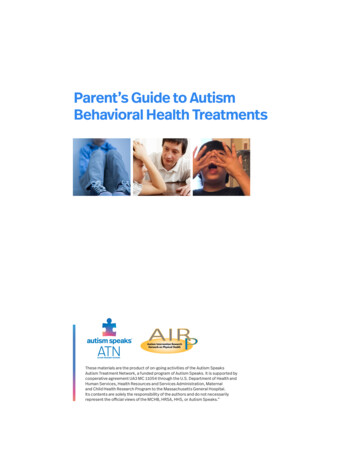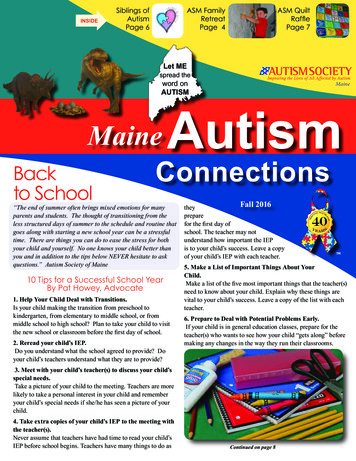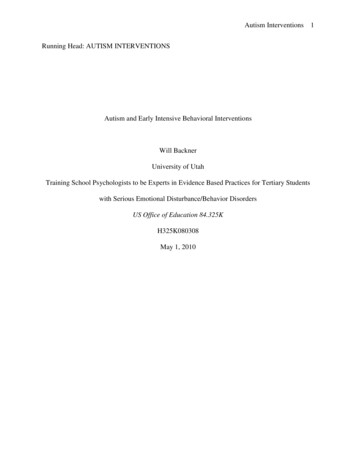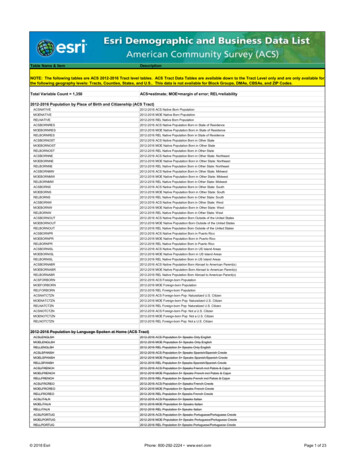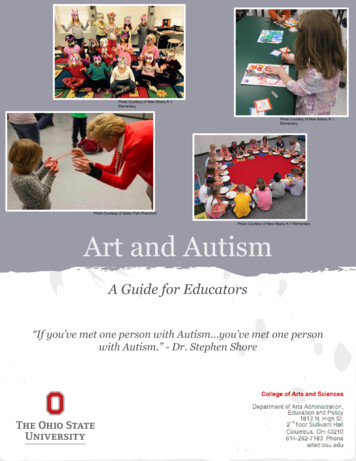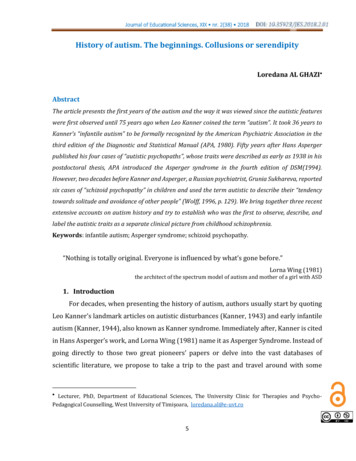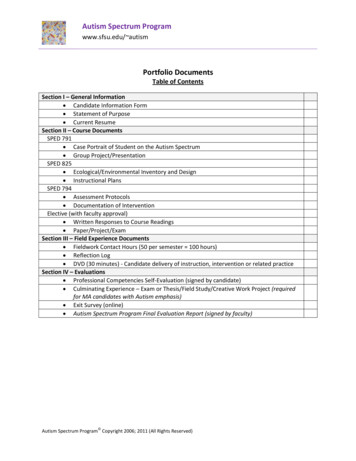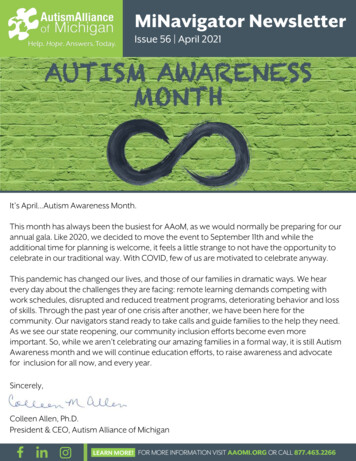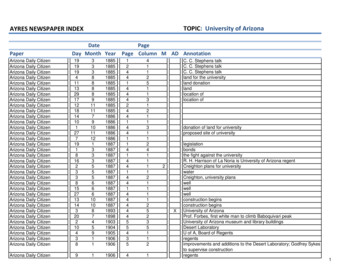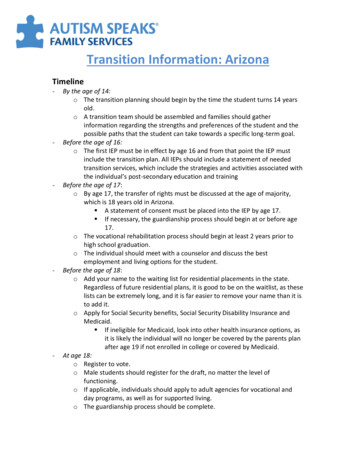
Transcription
Transition Information: ArizonaTimeline-----By the age of 14:o The transition planning should begin by the time the student turns 14 yearsold.o A transition team should be assembled and families should gatherinformation regarding the strengths and preferences of the student and thepossible paths that the student can take towards a specific long-term goal.Before the age of 16:o The first IEP must be in effect by age 16 and from that point the IEP mustinclude the transition plan. All IEPs should include a statement of neededtransition services, which include the strategies and activities associated withthe individual’s post-secondary education and trainingBefore the age of 17:o By age 17, the transfer of rights must be discussed at the age of majority,which is 18 years old in Arizona. A statement of consent must be placed into the IEP by age 17. If necessary, the guardianship process should begin at or before age17.o The vocational rehabilitation process should begin at least 2 years prior tohigh school graduation.o The individual should meet with a counselor and discuss the bestemployment and living options for the student.Before the age of 18:o Add your name to the waiting list for residential placements in the state.Regardless of future residential plans, it is good to be on the waitlist, as theselists can be extremely long, and it is far easier to remove your name than it isto add it.o Apply for Social Security benefits, Social Security Disability Insurance andMedicaid. If ineligible for Medicaid, look into other health insurance options, asit is likely the individual will no longer be covered by the parents planafter age 19 if not enrolled in college or covered by Medicaid.At age 18:o Register to vote.o Male students should register for the draft, no matter the level offunctioning.o If applicable, individuals should apply to adult agencies for vocational andday programs, as well as for supported living.o The guardianship process should be complete.
Starting the Transition Process:All transition assessments should be done when the student begins the transitionplanning process, which is usually at 14 years old. The IEP should consist of ideas aboutpost-secondary outcomes pertaining to employment, education and independent living.The plan should be as detailed as possible for the next few years of the student’s life.The first IEP must be in effect by age 16 and from that point the IEP must include thefollowing: An invite to the individual to attend their IEP meetingsMeasurable postsecondary goalsTransition assessmentsCoordinated activitiesFuture courses of studyAnnual IEP goalsTransfer of rights statement (the transfer or rights will occur at age 18)Summary of performanceEducation:To graduate, the only main options are to receive the high school graduation diploma ornot receive the diploma. Arizona provides minimum requirements and LEAs (localdistricts) sometimes add to those requirements for students with disabilities. Arizonadoes allow for alternate courses to be used to earn the required course credits and theperformance criteria is often lowered, as long as the disability is addressed individuallyin the IEP, detailing the differences in the coursework for the specific individual. Theindividuals are not required to pass the state exit exam in order to receive a high schooldiploma, if they have a disability. They often use different tests and different scorecriteria are used with each group of people, dependent on the level of their disorder toexit the school system. If they fail the exam, they are allowed to retake the same examonly twice. They do provide accommodations for those with disabilities to take theirexams in appropriate conditions.For information on Graduation and Students with Disabilities, as2.pdf.Guardianship/Conservatorship:While the transfer of rights should occur at the age of majority which is 18 years old, ifthe individual is declared legally incompetent prior to that age, the families have theoption to appoint someone to be their guardian over educational decisions. One option
is to have the child declared legally incompetent and then placed under theguardianship of a court-assigned individual who will make decisions for the child.However, that is a lengthy and expensive process. If a student is between the age of 18to 22, and has not been declared legally incompetent and can consent to the transfer oftheir rights to another person, they may be allowed to execute the Declaration of Rightto Make Educational Decisions. This will allow the students to appoint another person(e.g. parent) to make their education decisions for them, but they are also allowed toterminate that agreement at any time.Prepare Your Child for the Future: Transfer of Rights at Age of gov/ddpcVocational Rehabilitation:After contacting the Rehabilitation Services Administration, they will assign you with avocational rehabilitation counselor who will help identify the individual’s interests andtraining requirements, and then help you create an Individualize Plan for Employment(IPE).To apply you can contact your local VR office or use the aforementioned contactinformation. To find a local VR office, go to:www.azdes.gov/main.aspx?menu 32&id 1584.Social Security:Benefits should be applied for before the student’s 18th birthday and then be reevaluated after the student’s 18th birthday. It is also important that the office becontacted well in advance before the student’s 18th birthday to understand thateligibility and application process.Applicants may apply online or by contacting Social Security directly. Local SocialSecurity offices can be found using SSA's office locator or by calling (voice) 800-7721213 or (TTY) 800-325-0778.Social Security Administration: www.socialsecurity.govSocial Security Benefit Application: www.socialsecurity.gov/disabilityonlineSocial Security Benefits for People with Disabilities: www.ssa.gov/disabilitySocial Security Office Locator: https://secure.ssa.gov/ICON/main.jsp
Housing Resources:US Department of Housing and Urban Development: HUD in D/states/arizonaArizona Department of Housing: housing.az.govArizona Public Housing Agency Contact tates/az.cfmDisability.gov Guide to s-guide-housing
Other Arizona ResourcesState Department of Education: Special EducationExceptional Student ServicesArizona Department of Education(602) 542-4013www.ade.az.gov/essSecondary projects/secondary-transitionState Vocational Rehabilitation AgencyRehabilitation Services AdministrationDepartment of Economic Security(800) 563-1221(602) 542-3332www.azdes.gov/rsa/VRArizona Department of Housing(602) 771-1000housing.az.govArizona Health Care Cost Containment System602 417 4000www.ahcccs.state.az.us
Transition Information: Arizona Timeline -By the age of 14: o The transition planning should begin by the time the student turns 14 years old. o A transition team should be assembled and families should gather . After contacting the Rehabilitation Services Administration, they will assign you with a
